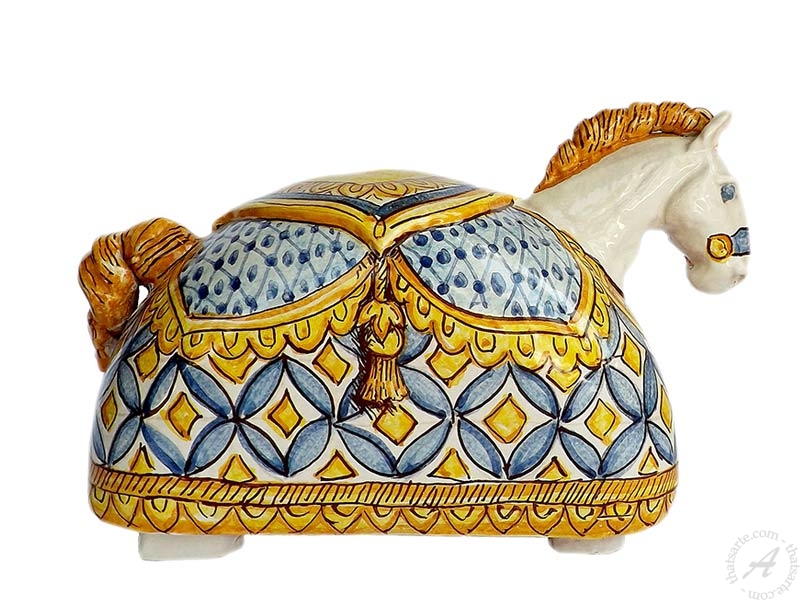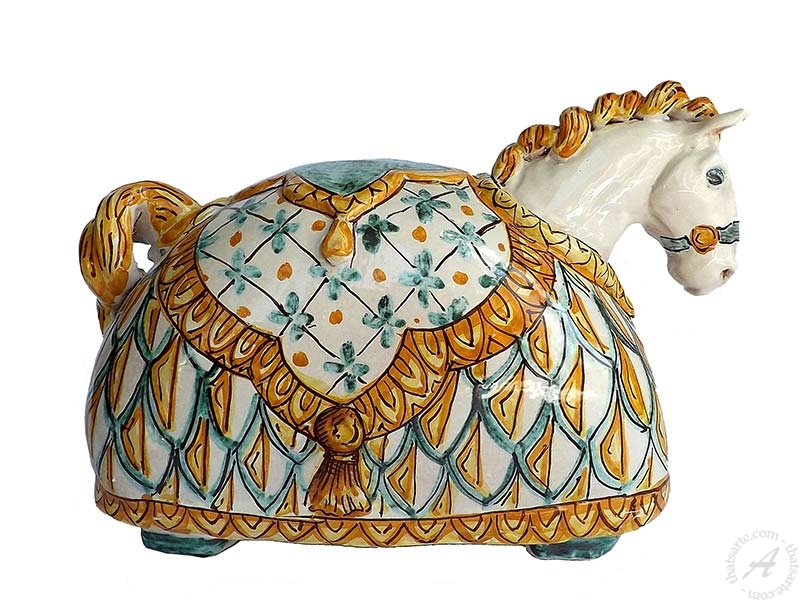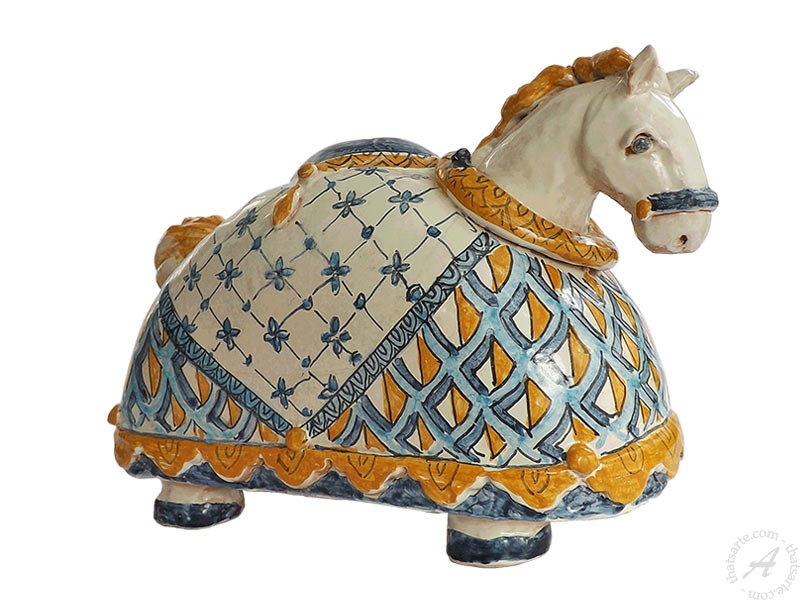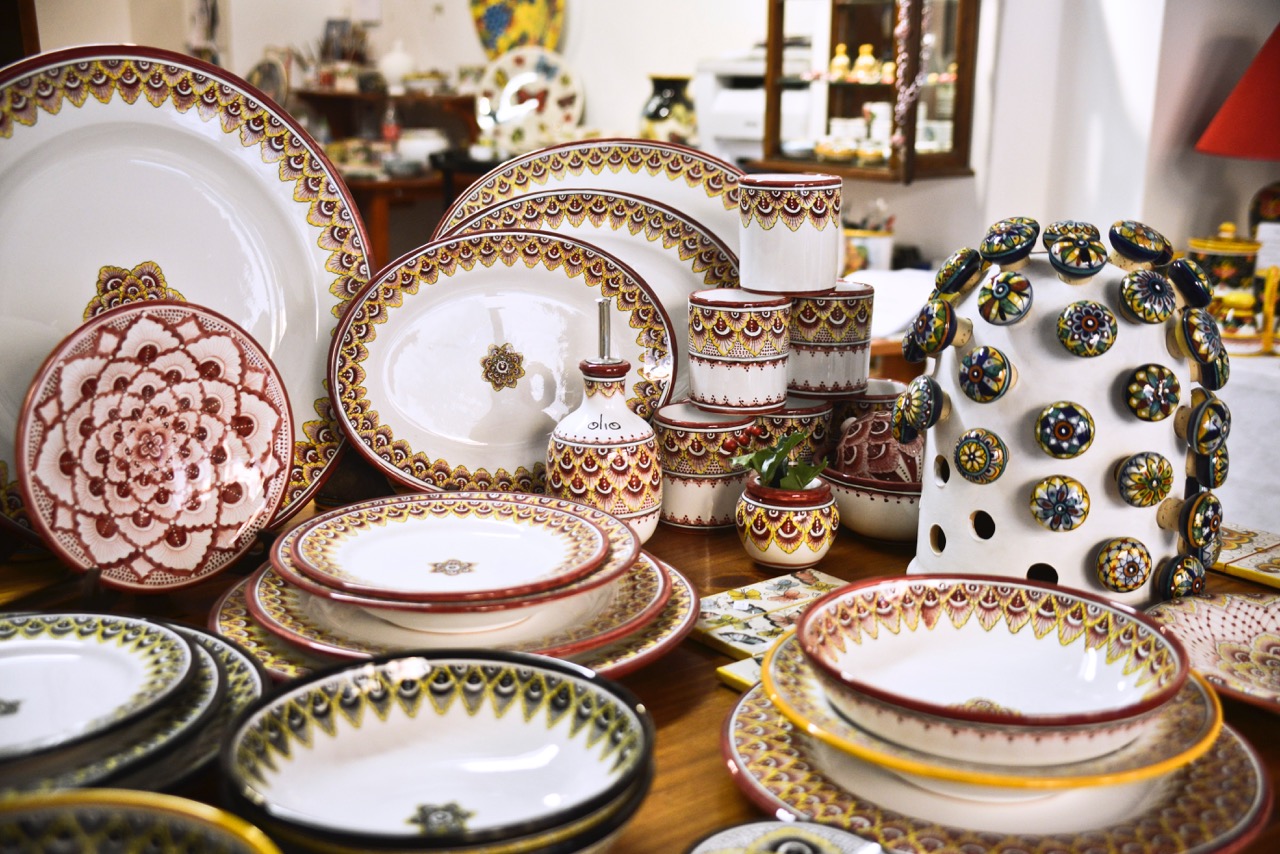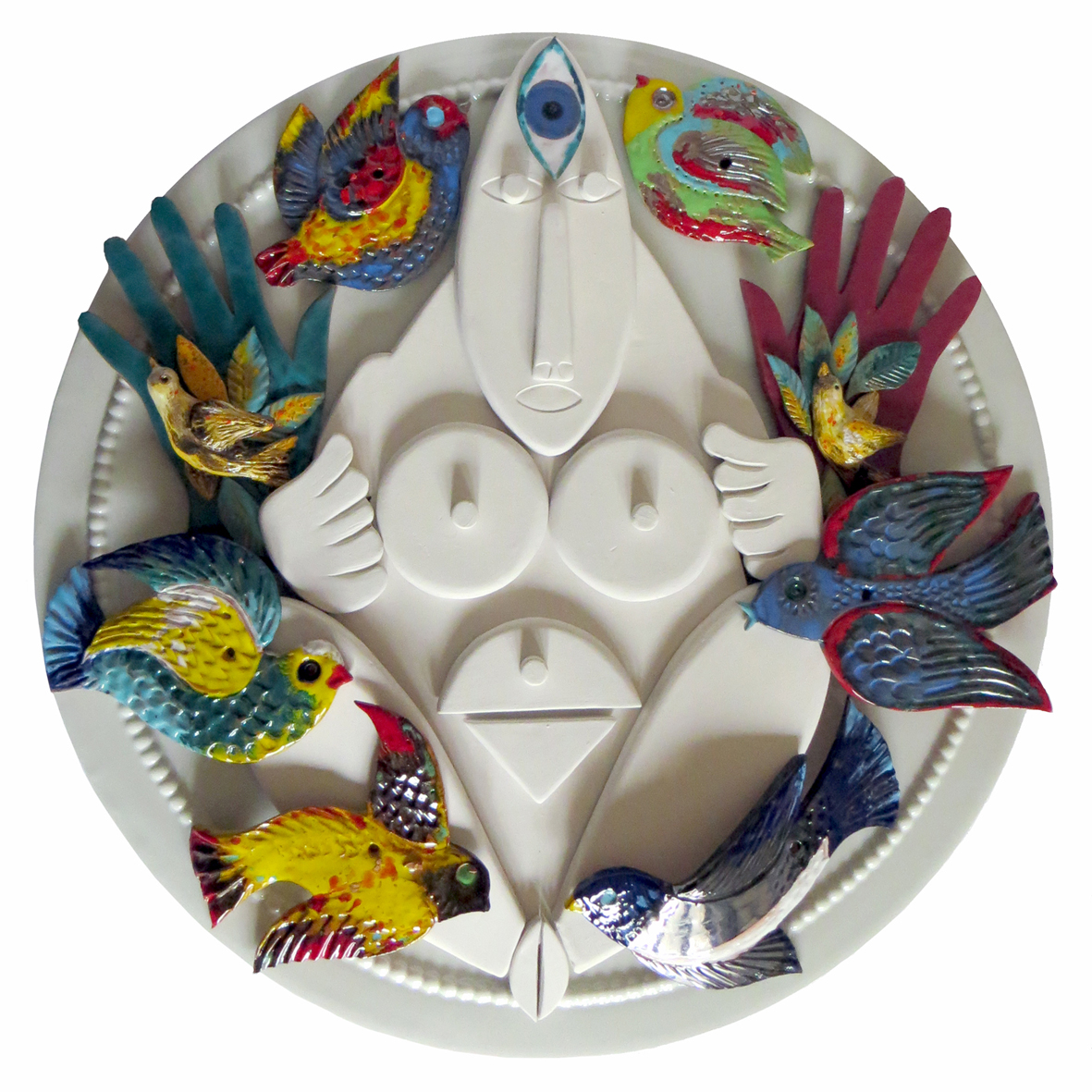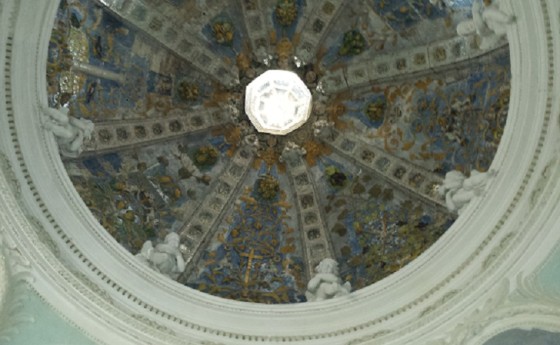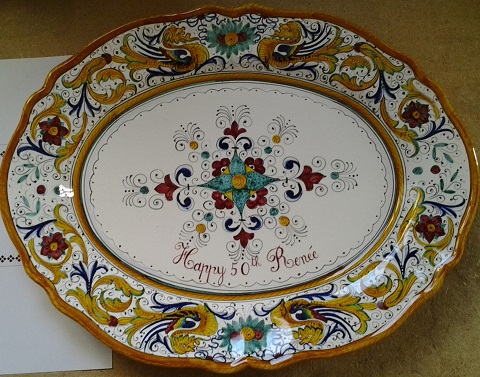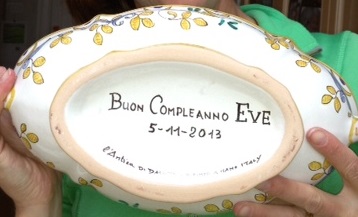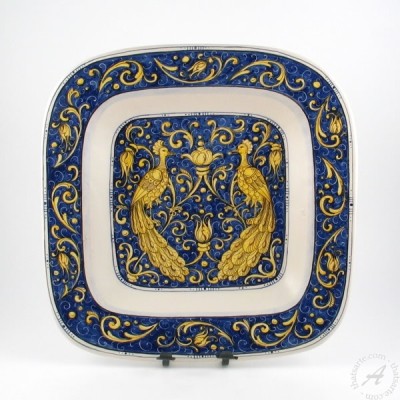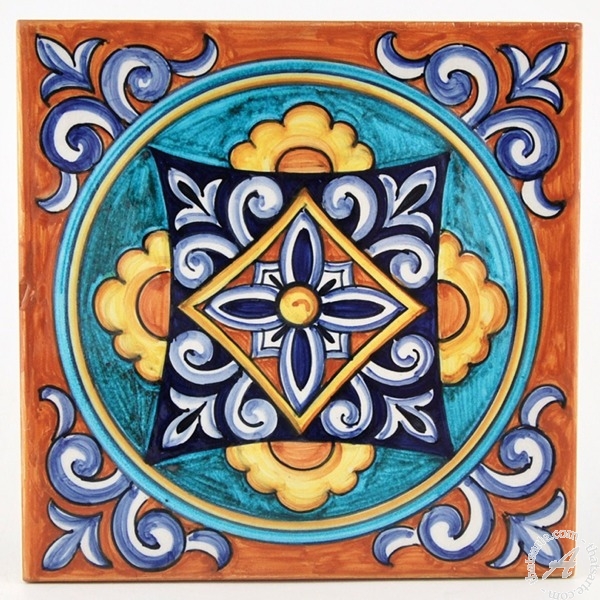Each time we see something new made by Ghenos we are stunned by its harmony and character. They do have a special gift: their pottery is unmistakably Sicilian, yet it’s never ordinary.
We have chosen for our website a collection of ceramic horses. They are simply adorable!
Author: Tiziana Manzetti
A new dinnerware collection from Deruta: Ceramiche Andrilia
It happened last year, on a windy, sunny day. We were strolling on the main square in Deruta – one of the most relevant ceramic villages in Italy – and Manuela pointed at a small pottery store, right next to Town Hall, that we had never noticed before. Sitting on a low stool, absorbed in the decoration of a dinner plate sat Marianna, the young owner of the place.
Vietri pottery: a feast for the senses
May 17-June 28, 2015
Vietri – Italy
Clara Garesio is the past, present and future of Vietri pottery. The title of her new exhibition is meaningful: An Endless Spring. And, indeed, the joy of Southern colors, the pulse of the Amalfi Coast, the harmony of Italy inhabit her work.
The exhibition will open in a few days in the Museum of Ceramics in Villa Guariglia that hosts a breathtaking collection of Vietry pottery. A must see.
A glazed terracotta dome – Santi Buglioni
The most beautiful things are the unexpected ones.
Last Sunday we decided for a trip to Bevagna (Umbria): a bit of sightseeing and some good food & wine to recharge the batteries after a busy week.
Bevagna is a small village not far from Perugia, with awesome buildings from the Middle Ages and the Renaissance, cobbled streets and peoples filling the main square after Sunday mass.
Strolling around, we stepped into Saint Frances Church and we found a jewel: a glazed terracotta dome made by Santi Buglioni.
We took some pictures with the mobile phone and, despite the poor light, we believe they manage to convey the beauty of this work that is, we were to discover, not very well known.
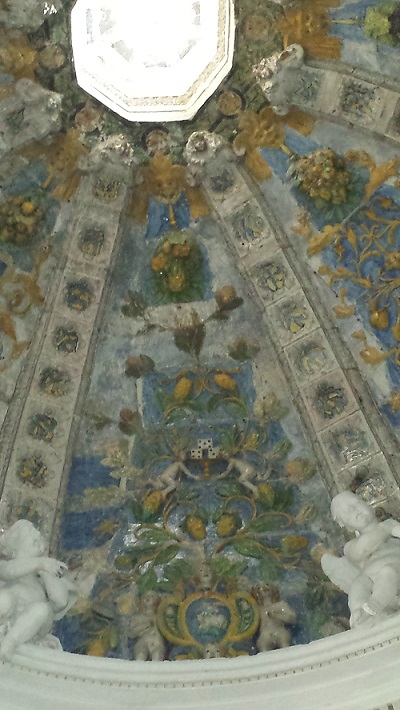
The author of the dome, Santi Buglioni, is an Italian sculptor who lived and worked in Florence in the 16th century, when glazed terracotta was a very popular decorative technique, thanks to the talents of the Della Robbia family.
Santi inherited the secrets of this technique and actually worked with Giovanni Della Robbia in the Ospedale del Ceppo, in Pistoia, one of his most famous works, where he sculpted the frieze that runs along the entire length of the loggia of the hospital, representing the Seven Acts of Mercy.
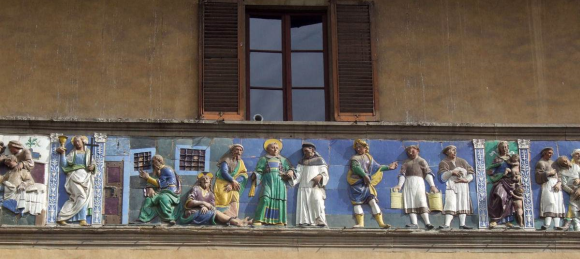
Santi Buglioni, detail of the frieze on the Loggia of the Ospedale del Ceppo, Pistoia – Credits “The red list” website
He was mostly active in Florence, where his glazed terracotta stille decorates the Biblioteca Laurenziana, Palazzo Vecchio and the Bargello.
By Tiziana Manzetti
Your favorite handmade Italian goods in 2014
Food for your thoughts, joy for your eyes… Our best selling Italian pottery and other goods. Strictly handmade. Our collection of hand painted Italian tiles is getting larger and larger, with many traditional designs from different Italian regions. Last year our Customers favorite tile was Tile 18 by Francesca Niccacci. 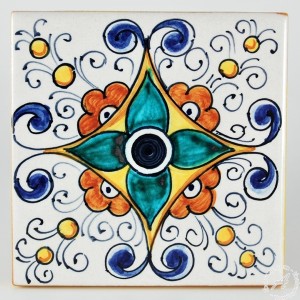 Italian tile panels are an old time favorite, for their versatile uses and distinctive impact of home décor. Our best seller in 2014 was Lemons by Ghenos, a lovely Sicilian panel.
Italian tile panels are an old time favorite, for their versatile uses and distinctive impact of home décor. Our best seller in 2014 was Lemons by Ghenos, a lovely Sicilian panel. 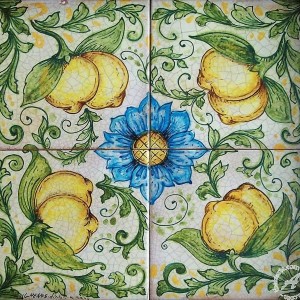
Why ask for Italian pottery personalization
The personalization is only one of the charming details that differentiate handmade pottery from machine made ceramics, yet it is perhaps the most valuable detail as it has the power to turn a nice object into a cherished piece of somebody’s life.
Most of the beautiful Italian pottery pieces that leave us breathless when we visit Museums or antique art galleries were made on commission and somehow personalized. The commissioner briefed the artist as to the message he wished the item to deliver and the artist decorated the pottery accordingly.
Especially popular as wedding gifts, large wall plates, urns, bowls and jars were carriers of moral lessons on beauty, virtue or timeless love, which took the form of images or mottos nicely painted in elaborate scrolls. Continue reading
Peacocks on Italian ceramics
A source of positive symbolic meanings, peacocks are prominent in Italian pottery.
Pliny the Elder, the Roman philosopher, described very well how the peacock replaces his entire tail of feathers annually. This fascinating event, together with the belief that the bird’s flesh never goes bad but dries naturally, entitled our ancestors to depict him as a symbol of resurrection, renewal and immortality.
Often the representation of the peacocks on Italian ceramic objects focuses on the “eyes” that decorate the birds magnificent tail. Occhio di pavone, the “peacock eye”, has been a popular motif on our pottery: for example on the rim of Renaissance wall plates, on large serving bowls, on our dinnerware.
Just added! Eugenio’s geometric tiles
I do hope we are not getting boring, despite our third post in a row about Italian tiles. The truth is that we never seem to get enough of them and the enthusiasm of our Customers about their unique interior design projects is so contagious!
So we have convinced Eugenio Ricciarelli, a dear friend and the very first pottery maker we added to our Italian pottery website, to paint for us a small collection of tiles, richly decorated, colorful and vibrant with energy.
We have imagined them on a tabletop, inlaid into wood or wrought iron, on the floor as an inlaid tile rug, on a backsplash mixed with solid tiles, as a wall panel over a bath tub … endless decorating solutions for one of most genuine products of Italian arts and crafts.
Italian tiles to love
Francesca Niccacci is an Italian ceramic painter from Deruta, winner of International prizes.
She is a great interpreter of historical and mythological scenes, featured in Museums and Churches around the world. Yet she loves the geometric designs that are so much “Deruta”. Francesca plays with them, taking them to a personal next step and applying them to wall plates and tiles.
We particularly like her tiles, so intricate and rich. She paints them in different designs and patterns, that are often a great inspiration for interior designers to create unique backsplashes or tiled surfaces.
Collecting Italian majolica floor tiles
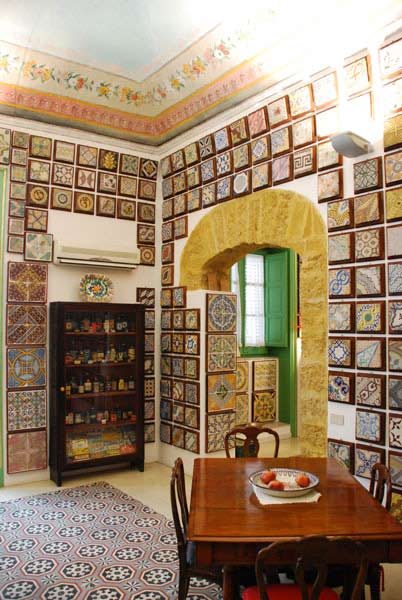 This story is about love and dedication, about beauty and craftsmanship, about history and heritage.
This story is about love and dedication, about beauty and craftsmanship, about history and heritage.
Pio Mellina is a man who turned his passion for antique Italian tiles into a dream and a few years ago the dream came true. He has created “Le Stanze al Genio”, a Museum in Palermo where visitors can explore his huge collection and marvel at the variety of designs, styles and colors. A display of Italic creative genius! Pio has been collecting antique Italian tiles since he was a child. Instead of joining his friend for a soccer match, he searched the little street markets in the old city. Tiles were cheap, as people did not know what to do with them. Sometimes they were just the waste of the renovation of old houses. Pio purchased them and stored them in his parent’s basement.
When the basement was packed with tiles and Pio could no longer locate what he was looking for, he started to organize them and to collect information as well. His studies changed his collecting habits: he learnt to appraise the tiles he found and purchased some very rare pieces. Pio’s wish to have a place of his own where the tiles could be displayed and appreciated by anyone grew over time, just like his collection. In 1998 he bought a flat in an ancient downtown building. He started the renovation with a twofold purpose: it had to be his home as well as the place where all his tiles could be beautifully displayed. In 2008 Pio Mellina’s house and museum was ready and opened to the public. Continue reading

